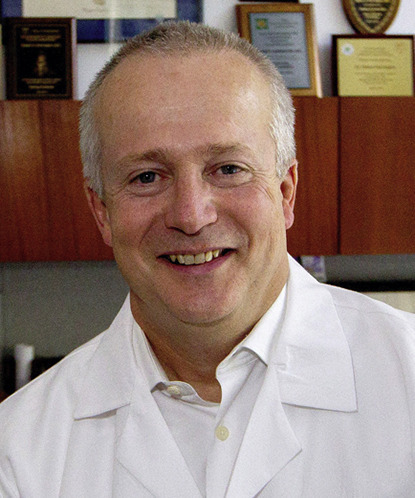



Hydroxychloroquine and azithromycin have been touted for potential prophylaxis or treatment for patients with coronavirus disease 2019 (COVID-19). Both drugs are listed as definite causes of torsade de pointes at crediblemeds.org. There are occasional case reports of hydroxychloroquine’s prolonging the QT interval and provoking torsade de pointes1, 2, 3, 4 when used to treat systemic lupus erythematosus. Antimalarial prophylactic drugs, such as hydroxychloroquine, are believed to act on the entry and post-entry stages of severe acute respiratory syndrome–associated coronavirus (SARS-CoV) and severe acute respiratory syndrome coronavirus 2 (SARS-CoV-2) infection, likely via effects on endosomal pH and the resulting underglycosylation of angiotensin-converting enzyme 2 receptors that are required for viral entry.5
The widely used antibiotic azithromycin is increasingly recognized as a rare cause of QT interval prolongation,6 , 7 serious arrhythmias,8 , 9 and increased risk for sudden death10; advanced age and female sex have been implicated as risk factors. Interestingly, azithromycin can also provoke non-pause-dependent polymorphic ventricular tachycardia.11 , 12 A U.S. Food and Drug Administration perspective supported the observations that azithromycin administration leaves the patient vulnerable to corrected QT (QTc) interval prolongation and torsade de pointes.13
Basic electrophysiological studies suggest that both drugs can provoke proarrhythmia via mechanisms beyond block of the rapidly activating delayed rectifier potassium current IKr implicated in usual cases of torsade de pointes.14 , 15 The effect of the combination of these agents on QT interval or arrhythmia risk has not been studied. There are very limited data evaluating the safety of combination therapy. Multiple randomized trials are currently being initiated.
Seriously ill patients often have comorbidities that can increase the risk for serious arrhythmias. These include hypokalemia, hypomagnesemia, fever,16 and an inflammatory state.17 Mechanisms to minimize arrhythmia risk include the following:
-
•Electrocardiographic/QT interval monitoring
-
1.Withhold the drugs in patients with baseline QT interval prolongation (e.g., QTc interval ≥500 ms) or with known congenital long-QT syndrome.
-
2.Monitor cardiac rhythm and QT interval, and withdraw the drugs if QTc interval exceeds a preset threshold of 500 ms.
-
3.In patients critically ill with COVID-19, frequent caregiver contact may need to be minimized, so optimal electrocardiographic interval and rhythm monitoring may not be possible.
-
1.
-
•
Correction of hypokalemia to a level of >4 mEq/l and hypomagnesemia to a level of >2 mg/dl
-
•
Avoidance of other QTc interval–prolonging agents 5 whenever feasible
Safety considerations for the use of hydroxychloroquine and azithromycin in clinical practice have been described.18
Some of the current COVID-19-repurposed drugs are listed in Table 1 .
Table 1.
Torsade de pointes potential and post-marketing adverse events associated with possible COVID-19-repurposed pharmacotherapies
| CredibleMeds classification | VT/VF/TdP/LQTS in FAERS | Cardiac arrest in FAERS | |
|---|---|---|---|
| Repurposed antimalarial agents | |||
| Chloroquine | Known risk | 72 | 54 |
| Hydroxychloroquine | Known risk | 222 | 105 |
| Repurposed antiviral agents | |||
| Lopinavir/ritonavir | Possible risk | 27 | 48 |
| Adjunct agents | |||
| Azithromycin | Known risk | 396 | 251 |
Reproduced with permission from Giudicessi et al.5
COVID-19 = coronavirus disease 2019; FAERS = U.S. Food and Drug Administration Adverse Event Reporting System; LQTS = long-QT syndrome; TdP = torsade de pointes.
Footnotes
This document has been copublished in the Journal of the American College of Cardiology and Circulation.
References
- 1.Chen C.Y., Wang F.L., Lin C.C. Chronic hydroxychloroquine use associated with QT prolongation and refractory ventricular arrhythmia. Clin Toxicol (Phila) 2006;44:173–175. doi: 10.1080/15563650500514558. [DOI] [PubMed] [Google Scholar]
- 2.Morgan N.D., Patel S.V., Dvorkina O. Suspected hydroxychloroquine-associated QT-interval prolongation in a patient with systemic lupus erythematosus. J Clin Rheumatol. 2013;19:286–288. doi: 10.1097/RHU.0b013e31829d5e50. [DOI] [PubMed] [Google Scholar]
- 3.O’Laughlin J.P., Mehta P.H., Wong B.C. Life threatening severe QTc prolongation in patient with systemic lupus erythematosus due to hydroxychloroquine. Case Reports in Cardiology. 2016;2016:4626279. doi: 10.1155/2016/4626279. [DOI] [PMC free article] [PubMed] [Google Scholar]
- 4.de Olano J., Howland M.A., Su M.K., Hoffman R.S., Biary R. Toxicokinetics of hydroxychloroquine following a massive overdose. Am J Emerg Med. 2019;37 doi: 10.1016/j.ajem.2019.158387. 2264.e5–e8. [DOI] [PubMed] [Google Scholar]
- 5.Giudicessi J.R., Noseworthy P.A., Friedman P.A., Ackerman M.J. Urgent guidance for navigating and circumventing the QTc prolonging and torsadogenic potential of possible pharmacotherapies for COVID-19. Mayo Clin Proc. https://www.elsevier.com/__data/assets/pdf_file/0004/996745/MCP_Possible-COVID-19-Pharmacotherapies.pdf Available at: [DOI] [PMC free article] [PubMed]
- 6.Choi Y., Lim H.-S., Chung D., Choi J.-G., Yoon D. Risk evaluation of azithromycin-induced QT prolongation in real-world practice. Biomed Res Int. 2018:1574806. doi: 10.1155/2018/1574806. [DOI] [PMC free article] [PubMed] [Google Scholar]
- 7.Sears S.P., Getz T.W., Austin C.O., Palmer W.C., Boyd E.A., Stancampiano F.F. Incidence of sustained ventricular tachycardia in patients with prolonged QTc after the administration of azithromycin: a retrospective study. Drugs Real World Outcomes. 2016;3:99–105. doi: 10.1007/s40801-016-0062-9. [DOI] [PMC free article] [PubMed] [Google Scholar]
- 8.Huang B.H., Wu C.H., Hsia C.P., Yin Chen C. Azithromycin-induced torsade de pointes. Pacing Clin Electrophysiol. 2007;30:1579–1582. doi: 10.1111/j.1540-8159.2007.00912.x. [DOI] [PubMed] [Google Scholar]
- 9.Kezerashvili A., Khattak H., Barsky A., Nazari R., Fisher J.D. Azithromycin as a cause of QT-interval prolongation and torsade de pointes in the absence of other known precipitating factors. J Interv Card Electrophysiol. 2007;18:243–246. doi: 10.1007/s10840-007-9124-y. [DOI] [PubMed] [Google Scholar]
- 10.Ray W.A., Murray K.T., Hall K., Arbogast P.G., Stein C.M. Azithromycin and the risk of cardiovascular death. N Engl J Med. 2012;366:1881–1890. doi: 10.1056/NEJMoa1003833. [DOI] [PMC free article] [PubMed] [Google Scholar]
- 11.Kim M.H., Berkowitz C., Trohman R.G. Polymorphic ventricular tachycardia with a normal QT interval following azithromycin. Pacing Clin Electrophysiol. 2005;28:1221–1222. doi: 10.1111/j.1540-8159.2005.50146.x. [DOI] [PubMed] [Google Scholar]
- 12.Yang Z., Prinsen J.K., Bersell K.R. Azithromycin causes a novel proarrhythmic syndrome. Circ Arrhythm Electrophysiol. 2017;10 doi: 10.1161/CIRCEP.115.003560. [DOI] [PMC free article] [PubMed] [Google Scholar]
- 13.Mosholder A.D., Mathew J., Alexander J.J., Smith H., Nambiar S. Cardiovascular risks with azithromycin and other antibacterial drugs. N Engl J Med. 2013;368:1665–1668. doi: 10.1056/NEJMp1302726. [DOI] [PubMed] [Google Scholar]
- 14.Zhang M., Xie M., Li S. Electrophysiologic studies on the risks and potential mechanism underlying the proarrhythmic nature of azithromycin. Cardiovasc Toxicol. 2017;17:434–440. doi: 10.1007/s12012-017-9401-7. [DOI] [PubMed] [Google Scholar]
- 15.Capel R.A., Herring N., Kalla M. Hydroxychloroquine reduces heart rate by modulating the hyperpolarization-activated current If: novel electrophysiological insights and therapeutic potential. Heart Rhythm. 2015;12:2186–2194. doi: 10.1016/j.hrthm.2015.05.027. [DOI] [PMC free article] [PubMed] [Google Scholar]
- 16.Kauthale R.R., Dadarkar S.S., Husain R., Karande V.V., Gatne M.M. Assessment of temperature-induced hERG channel blockade variation by drugs. J Appl Toxicol. 2015;35:799–805. doi: 10.1002/jat.3074. [DOI] [PubMed] [Google Scholar]
- 17.Aromolaran A.S., Srivastava U., Ali A. Interleukin-6 inhibition of hERG underlies risk for acquired long QT in cardiac and systemic inflammation. PLoS ONE. 2018;13 doi: 10.1371/journal.pone.0208321. [DOI] [PMC free article] [PubMed] [Google Scholar]
- 18.Simpson T.F., Kovacs R.J., Stecker E.C. Ventricular arrhythmia risk due to hydroxychloroquine-azithromycin treatment for COVID-19. https://www.acc.org/latest-in-cardiology/articles/2020/03/27/14/00/ventricular-arrhythmia-risk-due-to-hydroxychloroquine-azithromycin-treatment-for-covid-19 Available at: Accessed April 2, 2020.


